ولاية قوصوة
| ولاية كوسوڤو ولايت قوصوه Vilâyet-i Kosova Kosovski Vilajet/Косовски Вилајет Косовски вилает | |||||||||||||
|---|---|---|---|---|---|---|---|---|---|---|---|---|---|
| ولاية الدولة العثمانية | |||||||||||||
| 1877–1913 | |||||||||||||
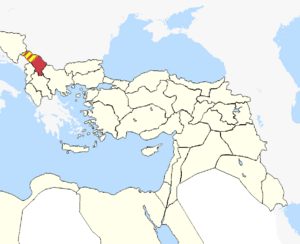 ولاية كوسوڤو في عام 1900، المنطقة التي احتلتها مملكة النمسا-المجر (إقليم السنجق) مهشـّرة | |||||||||||||
| العاصمة | اوسكوب[1] (Skopje) | ||||||||||||
| التعداد | |||||||||||||
• 1911[2] | 1602949 | ||||||||||||
| التاريخ | |||||||||||||
| التاريخ | |||||||||||||
• Established | 1877 | ||||||||||||
| 1913 | |||||||||||||
| |||||||||||||
| اليوم جزء من | |||||||||||||
ولاية كوسوڤو، هي إحدى ولايات الدولة العثمانية في شبه جزيرة البلقان التي شملت الأراضي الحالية لكوسوڤو والجزء الغربي من جمهورية مقدونيا. المناطق، اليوم، تضم إقليم السنجق (راشكا) من صربيا والجبل الأسود الحاليتين، بالرغم من تبعيتها القانونية للدولة العثمانية، إلى أنها كانت في الواقع محتلة من مملكة النمسا-المجر من 1878 إلى 1909، كما نص البند رقم 25 من معاهدة برلين. أوسكوب (سكوپيه) عملت كعاصمة للولاية ونقطة الوصل بين اسطنبول وولاياتها الأوروپية. تعداد سكان أوسكوب الذي ناهز 32,000 نسمة جعلها أكبر مدينة في الولاية، تليها پرزرن، بتعداد 30,000.
تاريخ
سنوات التشكل 1877–79
ولاية قوصوة أنشئت في 1877، وتكونت من مساحة أكبر كثيراً من كوسوڤو الحالية، إذ ضمت أيضاً سنجق نوڤي پازار و سنجق نيش (حتى 1878) والمنطقة حول پلاڤ و گوسينيه وكذلك منطقة دبرا.[3] تلك المناطق كانت في السابق تتبع إيالة نيش و إيالة أوسكوب ، وبعد 1865، ولاية الدانوب. In 1868 the Vilayet of Prizren was created with the sanjaks of Prizren, Dibra, Skopje and Nis, but it ceased to exist in 1877.[3]
أثناء وبعد الحرب الصربية العثمانية في 1876–78، ما بين 30,000 و 70,000 مسلم، معظمهم ألبان، طردهم الجيش الصربي من سنجق نيش و فرّوا إلى ولاية قوصوة.[4][5][6][7][8][9]
In 1878, the League of Prizren was created by Albanians from four vilayets including the Vilayet of Kosovo. The League's purpose was to resist Ottoman rule and incursions by the newly emerging Balkan nations.
The Kumanovo Uprising took place in early 1878 organized by an assembly of chiefs of the districts (Ottoman kaza) of Kumanovo, Kriva Palanka and Kratovo in the Vilayet of Kosovo (in modern-day northern Republic of Macedonia) seeking to liberate the region from the hands of the Ottoman Empire and unify it with the Principality of Serbia, which was at war with the Ottomans at that time. With the Serbian Army's liberation of Niš (11 January 1878) and Vranje (31 January 1878), the rebellion had been activated during the latter event with guerrilla fighting. The rebels received secret aid from the Serbian government, though the uprising only lasted four months, until its suppression by the Ottomans.
The province's boundaries shifted as the Ottoman Empire lost territory to neighboring states in the Treaty of Berlin following the Russo-Turkish War of 1877–1878 and parts were also internally transferred to Monastir Vilayet and from Salonica Vilayet. In 1879, western parts of the Sanjak of Novi Pazar, fell under Austro-Hungarian occupation in accord with the Berlin treaty which also allowed the Austro-Hungarian occupation of Bosnia and Herzegovina (remaining as such until 1908).
الاستجماع والأزمة 1879–1913
Two major administrative changes happened in 1880 and 1902. In order to counter Austro-Hungarian military presence in western parts of the Sanjak of Novi Pazar, a new province was created in 1880: the Sanjak of Pljevlja (Taşlica) with kazas: Pljevlja, Prijepolje and Priboj. In 1902, kazas of Mitrovica and Novi Pazar were transferred to Sanjak of Pristina, and kazas of Berane and Rožaje to Sanjak of Ipek. In the same time, Sanjak of Sjenica (Seniçe) was created with kazas: Sjenica, Nova Varoš, Bijelo Polje and Lower Kolašin.
في 1901، وقعت مذابح للصرب على أيدي الألبان في شمال كوسوڤو و پرشتينا.
In 1910, an Albanian-organised insurrection broke out in Pristina and soon spread to the entire vilayet of Kosovo, lasting for three months. The Ottoman sultan visited Kosovo in June 1911 during peace settlement talks covering all Albanian-inhabited areas.
ديموگرافيا
خريطة عرقية للبلقان من نصير اليونانيين [10] A. Synvet of 1877, الأستاذ الفرنسي في الليسيه العثماني في اسطنبول.
التقسيمات الإدارية
سناجق الولاية:[11]
- سنجق اوسكوب
- سنجق پريشتينا
- سنجق Seniçe
- سنجق دوقاگجين
- سنجق Taslica
- سنجق پریزرن
الحكومة
حكام (ولاة) الولاية:
- 1819-1893 : ابراهيم أدهم باشا Held office from (5 فبراير 1877 – 11 يناير 1878)
- 1894-1899 : حافظ محمد باشا
- 1900-1902 : رشاد باشا بك
- 1903-1904 : شاكر پاشا نعمان
- 1905-1907 : محمد شفقت پاشا
- . . . . 1908 : هادي باشا
- 1909-1910 : مظهر باي پاشا
- . . . . 1911 : خليل باشا بك
- . . . . 1912 : غالب باشا
الهوامش والمصادر
الهوامش:
| a. | ^ Kosovo is the subject of a territorial dispute between Serbia and the local Albanian majority. The Assembly of Kosovo declared its independence on 17 February 2008, a move that is recognised and the Republic of China (Taiwan), but not by Serbia, which claims it as part of its sovereign territory. |
المصادر
- ^
 Chisholm, Hugh, ed. (1911). "Uskub". دائرة المعارف البريطانية (eleventh ed.). Cambridge University Press.
Chisholm, Hugh, ed. (1911). "Uskub". دائرة المعارف البريطانية (eleventh ed.). Cambridge University Press. {{cite encyclopedia}}: Cite has empty unknown parameter:|coauthors=(help) - ^ Teaching Modern Southeast European History. Alternative Educational Materials, p. 26
- ^ أ ب Conflicting Loyalties in the Balkans: The Great Powers, the Ottoman Empire ...
- ^ Pllana, Emin (1985). "Les raisons de la manière de l'exode des refugies albanais du territoire du sandjak de Nish a Kosove (1878–1878) [The reasons for the manner of the exodus of Albanian refugees from the territory of the Sanjak of Niš to Kosovo (1878–1878)] ". Studia Albanica. 1: 189–190.
- ^ Rizaj, Skënder (1981). "Nënte Dokumente angleze mbi Lidhjen Shqiptare të Prizrenit (1878–1880) [Nine English documents about the League of Prizren (1878–1880)]". Gjurmine Albanologjike (Seria e Shkencave Historike). 10: 198.
- ^ Şimşir, Bilal N, (1968). Rumeli’den Türk göçleri. Emigrations turques des Balkans [Turkish emigrations from the Balkans]. Vol I. Belgeler-Documents. p. 737.
- ^ Bataković, Dušan (1992). The Kosovo Chronicles. Plato.
- ^ Elsie, Robert (2010). Historical Dictionary of Kosovo. Scarecrow Press. p. XXXII. ISBN 9780333666128.
- ^ Stefanović, Djordje (2005). "Seeing the Albanians through Serbian eyes: The Inventors of the Tradition of Intolerance and their Critics, 1804–1939." European History Quarterly. 35. (3): 470.
- ^ Robert Shannan Peckham, Map mania: nationalism and the politics of place in Greece, 1870–1922, Political Geography, 2000, p.4, [1] "Other maps by amongst others the Frenchman F. Bianconi [1877]، الذي كان كبير المعماريين والمهندسين في السكك الحديدية العثمانية، A. Synvet [1877] and Karl Sax [1878]، القنصل النمساوي السابق في أدريانوپل، كانا بالمثل منحازين لليونانيين."
- ^ Kosova Vilayeti | Tarih ve Medeniyet
أدب
- Sûreti defter-i sancak-i Arvanid, H. Inalcik, Ankara 1954. (Turkish)
- Sûreti defter-i esami vilayeti Dibra, f. 124-176, Başbakanlık Arşivi, maliyeden müdever, nr.508. (Turkish)
- Regjistri turk i vitit 1485* - Prof. As. Dr. David Luka (Albanian)
- A.F. Gilferding, Putovanje po Hercegovini, Bosni i Staroj Srbiji, Sarajevo, 1972, 241-245 (Serbian)
وصلات خارجية
![]() Chisholm, Hugh, ed. (1911). "Kossovo". دائرة المعارف البريطانية (eleventh ed.). Cambridge University Press.
Chisholm, Hugh, ed. (1911). "Kossovo". دائرة المعارف البريطانية (eleventh ed.). Cambridge University Press. {{cite encyclopedia}}: Cite has empty unknown parameter: |coauthors= (help)
- Map
- The Guardian, February 2008
 Media related to Vilayet of Kosovo at Wikimedia Commons
Media related to Vilayet of Kosovo at Wikimedia Commons
- مقالات المعرفة المحتوية على معلومات من دائرة المعارف البريطانية طبعة 1911
- Former country articles requiring maintenance
- إيالات الدولة العثمانية
- Pages using infobox former subdivision with unknown parameters
- Unclassified articles missing geocoordinate data
- All articles needing coordinates
- انحلالات 1912
- العهد العثماني في تاريخ كوسوڤو
- العهد العثماني في تاريخ جمهورية مقدونيا
- مقدونيا تحت الحكم العثماني
- ولايات الدولة العثمانية في اوروپا
- ولايات وأقاليم تأسست في 1864
- صربيا العثمانية
- ألبانيا العثمانية
- العهد العثماني في تاريخ الجبل الأسود
- تأسيسات 1877 في الدولة العثمانية
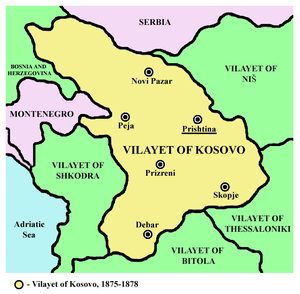
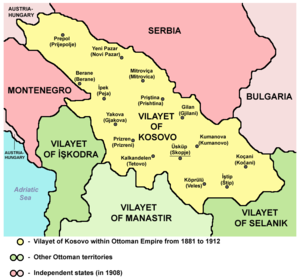
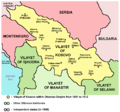

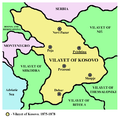

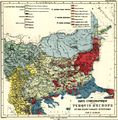
![خريطة عرقية للبلقان من نصير اليونانيين [10] A. Synvet of 1877, الأستاذ الفرنسي في الليسيه العثماني في اسطنبول.](/w/images/thumb/8/87/Balkans-ethnic_%281877%29.jpg/116px-Balkans-ethnic_%281877%29.jpg)